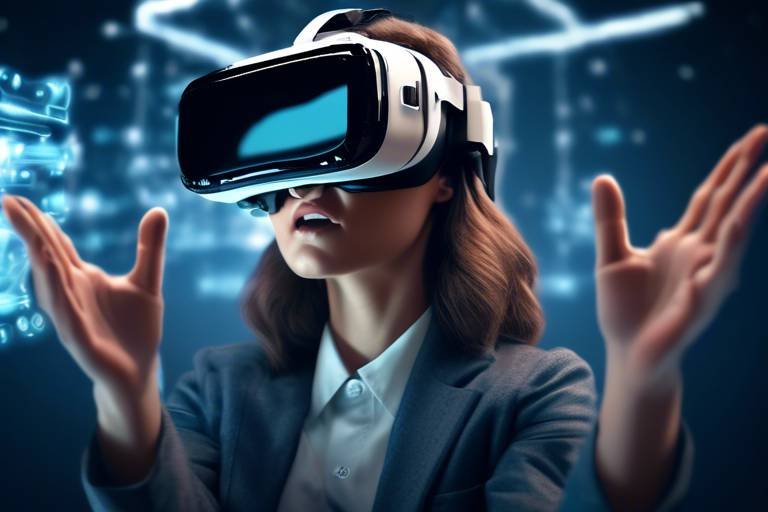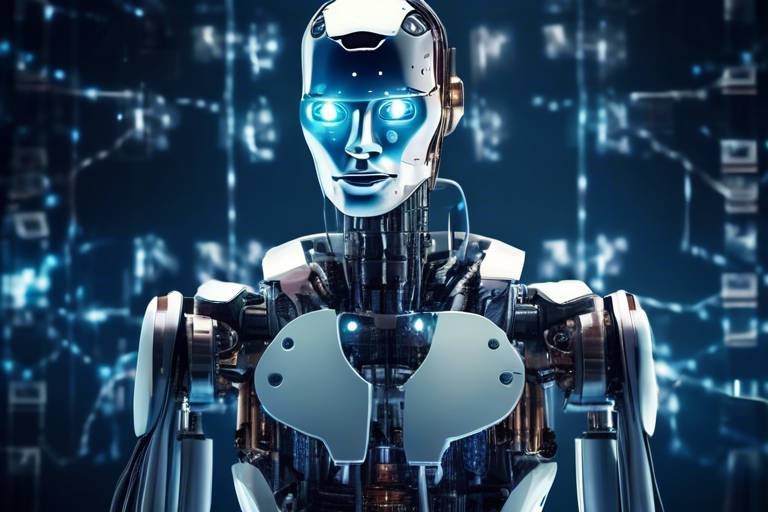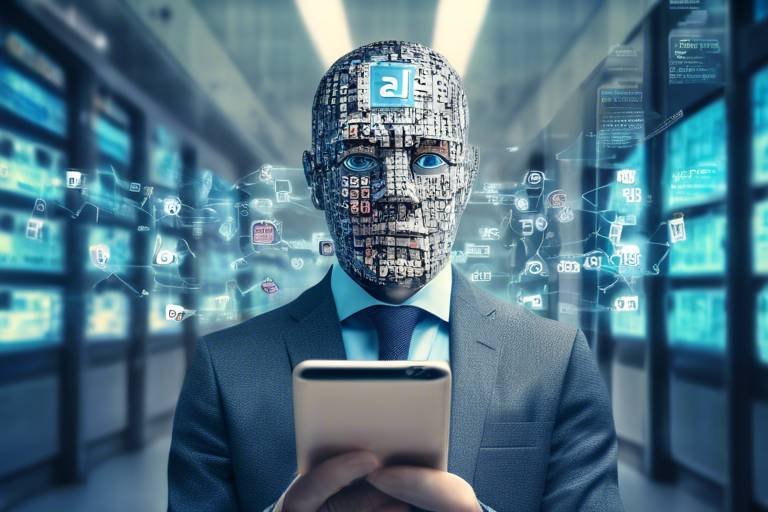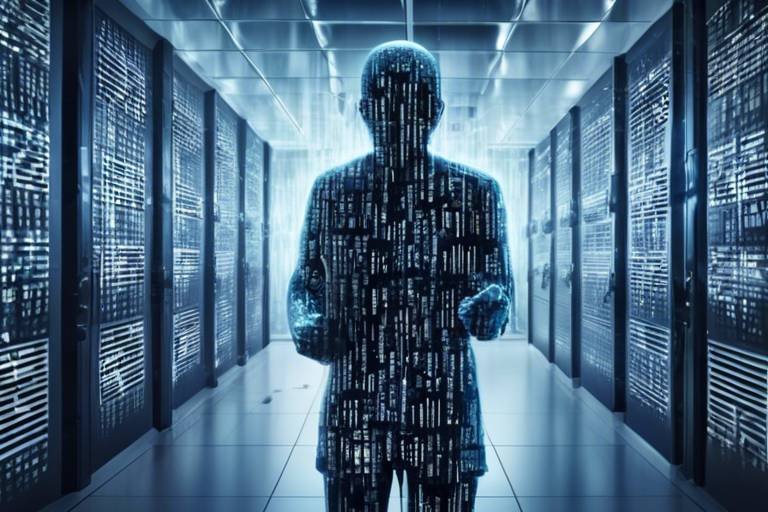The Role of AI in Smart Cities
In today's fast-paced world, the concept of smart cities is rapidly gaining traction, transforming the way we think about urban living. Imagine a city where everything is interconnected, where technology works seamlessly to enhance the quality of life for its residents. This is not just a futuristic dream; it's becoming a reality thanks to the power of artificial intelligence (AI). By harnessing innovative technologies and data-driven solutions, AI is revolutionizing urban environments, making them more efficient, sustainable, and livable.
AI is at the heart of this transformation, acting as the brain that processes vast amounts of data collected from various sources throughout the city. From traffic lights that adjust in real-time to reduce congestion to energy systems that optimize consumption and minimize waste, AI is paving the way for smarter urban infrastructure. But what exactly does this mean for the average citizen? It means less time spent in traffic, reduced energy bills, and improved public services, all of which contribute to a better quality of life.
Moreover, the integration of AI into city planning and management not only enhances operational efficiency but also promotes sustainability. For example, AI can analyze environmental data to help city planners make informed decisions about resource allocation and infrastructure development. This data-driven approach ensures that cities are not only built for today but are also prepared to meet the challenges of tomorrow, such as climate change and population growth.
As we delve deeper into the role of AI in smart cities, we will uncover how various AI technologies are powering this urban revolution. From machine learning applications that optimize traffic and energy consumption to data analytics that inform urban planning, the benefits of AI are plentiful. However, it's essential to also consider the challenges that come with this transformation, such as privacy concerns and the digital divide. Let's explore these aspects further to understand the full impact of AI on our urban landscapes.
- What are smart cities? Smart cities leverage technology and data to enhance the quality of life for residents, improve urban services, and promote sustainability.
- How does AI improve traffic management? AI analyzes real-time data to optimize traffic flow, reduce congestion, and enhance overall travel efficiency.
- What challenges do smart cities face? Key challenges include privacy concerns, data security, and ensuring equitable access to technology for all residents.
- How can citizens benefit from smart city initiatives? Citizens benefit through improved public services, reduced costs, and a more sustainable living environment.

Understanding Smart Cities
In today’s fast-paced world, the concept of smart cities has emerged as a beacon of hope for urban environments. But what exactly is a smart city? At its core, a smart city utilizes technology and data to enhance the quality of life for its residents while promoting sustainability and efficiency. Imagine a city where traffic flows smoothly, energy consumption is optimized, and public services are delivered seamlessly. This vision is becoming a reality, thanks to the integration of various technologies that work in harmony.
Smart cities are characterized by several key components, including:
- IoT (Internet of Things): Devices connected to the internet that collect and share data.
- Data Analytics: Tools that analyze vast amounts of data to inform decision-making.
- Artificial Intelligence: Technologies that learn from data to improve processes and services.
- Smart Infrastructure: Buildings and transportation systems designed to be efficient and sustainable.
These components work together to create an urban ecosystem that is not only responsive to the needs of its inhabitants but also proactive in addressing challenges. For instance, smart waste management systems can use sensors to detect when bins are full, optimizing collection routes and reducing fuel consumption. Similarly, smart lighting systems can adjust brightness based on pedestrian activity, enhancing safety while conserving energy.
Furthermore, the integration of renewable energy sources and smart grids allows cities to manage energy distribution more effectively, reducing reliance on fossil fuels and minimizing environmental impact. With real-time data at their fingertips, city planners can make informed decisions that shape the future of urban living. The result? A sustainable, livable, and efficient environment that caters to the needs of all residents.
However, the journey towards becoming a smart city is not without its challenges. Cities must navigate issues such as funding, infrastructure, and the digital divide to ensure that these technologies are accessible to everyone. As we delve deeper into the role of AI in smart cities, it's essential to recognize that the ultimate goal is to create a harmonious balance between technology and human experience.

AI Technologies Powering Smart Cities
The integration of artificial intelligence (AI) technologies is revolutionizing the way urban environments operate, making them smarter, more efficient, and sustainable. In the heart of this transformation lies a suite of AI tools that are not only enhancing infrastructure but also improving the quality of life for residents. From machine learning to data analytics, these technologies are reshaping urban landscapes by providing innovative solutions to age-old problems.
One of the most significant contributions of AI to smart cities is through machine learning. This technology enables systems to learn from data patterns and improve their performance over time without explicit programming. For instance, traffic management systems utilize machine learning algorithms to analyze real-time data from various sources, such as traffic cameras and sensors, to predict congestion and optimize traffic flow. This not only reduces travel times but also minimizes fuel consumption and emissions, contributing to a cleaner environment.
Moreover, AI is also instrumental in enhancing energy efficiency in urban areas. Smart grids powered by AI can predict energy demands and adjust supply accordingly, ensuring that energy is used efficiently. This predictive capability leads to significant cost savings for municipalities and residents alike. Additionally, AI-driven predictive maintenance in public utilities helps identify potential issues before they escalate into costly repairs, further promoting sustainability and operational efficiency.
Data analytics plays a crucial role in the decision-making processes of smart cities. By leveraging vast amounts of data collected from various sources, city planners can make informed choices about infrastructure development and resource allocation. For example, AI can analyze demographic data to identify areas that require more public services, such as parks or healthcare facilities, ensuring that resources are allocated where they are needed most.
| AI Technology | Application | Benefits |
|---|---|---|
| Machine Learning | Traffic Management | Reduces congestion, improves travel times |
| Smart Grids | Energy Management | Cost savings, efficient energy use |
| Data Analytics | Urban Planning | Informed decision-making, resource allocation |
In conclusion, the role of AI technologies in smart cities is multifaceted, enhancing various aspects of urban life. As these technologies continue to evolve, they hold the promise of creating urban environments that are not only more efficient but also more livable. By harnessing the power of AI, cities can address challenges related to congestion, energy consumption, and resource management, paving the way for a sustainable future.
- What are smart cities? Smart cities utilize technology and data analytics to enhance the quality of urban life.
- How does AI improve traffic management? AI analyzes real-time data to optimize traffic flow and reduce congestion.
- What is a smart grid? A smart grid is an electricity supply network that uses digital technology to monitor and manage the transport of electricity.
- How can AI contribute to sustainability in cities? AI helps in optimizing energy consumption, reducing waste, and improving resource management.

Machine Learning Applications
When we think about the bustling life of a city, it’s easy to get lost in the chaos of traffic jams, energy consumption, and public safety concerns. But what if I told you that machine learning, a subset of artificial intelligence, is stepping in like a superhero to save the day? By analyzing vast amounts of data, machine learning algorithms can optimize city operations in ways that were once unimaginable. Imagine a world where traffic flows smoothly, energy is used efficiently, and public safety is enhanced—all thanks to the power of AI!
One of the most exciting applications of machine learning in smart cities is in traffic management. Traditional traffic systems often rely on fixed signals and schedules, which can lead to congestion and frustration. However, with AI-driven traffic management systems, cities can process real-time data from various sources, such as sensors and cameras, to make informed decisions. This means that traffic lights can adjust dynamically based on current conditions, reducing wait times and improving the overall flow of vehicles. Think of it as having a traffic conductor who can adapt to the rhythm of the city!
Moreover, machine learning doesn’t stop at traffic management. It also plays a crucial role in enhancing energy efficiency. Smart grids powered by AI can predict energy demand patterns and optimize the distribution of resources accordingly. For instance, machine learning algorithms analyze historical usage data to forecast peak demand periods, allowing utilities to manage their resources better and reduce waste. This not only leads to cost savings but also minimizes environmental impact, creating a win-win scenario for both the city and its residents.
Furthermore, public safety is another area where machine learning shines. By analyzing data from various sources, including surveillance cameras and social media feeds, machine learning models can identify patterns that may indicate potential safety threats. For example, cities can deploy predictive policing strategies, where AI analyzes crime data to forecast areas that may require increased police presence. This proactive approach not only enhances public safety but also fosters a sense of security among residents.
In summary, the applications of machine learning in smart cities are vast and varied. From optimizing traffic flow to enhancing energy efficiency and public safety, the integration of AI technologies is transforming urban environments into more livable spaces. As we continue to embrace these innovations, the future of our cities looks brighter than ever, paving the way for a sustainable and efficient urban experience.
- What is machine learning? Machine learning is a subset of artificial intelligence that enables systems to learn and improve from experience without being explicitly programmed.
- How does machine learning help in traffic management? Machine learning analyzes real-time data to optimize traffic signals and improve flow, reducing congestion and travel times.
- Can machine learning contribute to energy efficiency? Yes, it can predict energy demand and optimize resource distribution, leading to cost savings and reduced environmental impact.
- What role does machine learning play in public safety? Machine learning can analyze data to identify patterns and forecast potential safety threats, enabling proactive measures for crime prevention.

Traffic Management Solutions
In today's bustling urban environments, traffic congestion can feel like an unavoidable reality, often leading to frustration and lost time. However, with the advent of AI-driven traffic management solutions, cities are beginning to tackle these issues head-on. Imagine a city where real-time data is utilized to optimize traffic flow, reduce waiting times, and enhance overall mobility. Sounds like a dream, right? Well, it's rapidly becoming a reality!
At the heart of these solutions are advanced algorithms that analyze data from various sources, including traffic cameras, sensors embedded in roads, and even GPS data from vehicles. This data is processed in real-time, allowing city planners to make informed decisions that can significantly improve traffic conditions. For instance, when an accident occurs, AI systems can quickly reroute traffic, activate warning signals, and even adjust traffic light patterns to alleviate congestion.
Moreover, these intelligent systems can predict traffic patterns based on historical data and current conditions. By identifying peak times and potential bottlenecks, cities can implement proactive measures. For example, they might adjust public transportation schedules or enhance infrastructure in high-traffic areas. This not only improves the flow of vehicles but also encourages the use of public transport, contributing to a more sustainable urban environment.
To illustrate the effectiveness of AI in traffic management, consider the following table that summarizes key benefits:
| Benefit | Description |
|---|---|
| Reduced Congestion | Real-time data analysis allows for immediate adjustments to traffic signals and routing, minimizing delays. |
| Improved Safety | AI can detect unusual patterns and alert authorities to potential hazards, enhancing public safety. |
| Environmental Impact | By optimizing traffic flow, AI reduces emissions and contributes to cleaner air in urban areas. |
| Enhanced Public Transport | AI systems can coordinate public transport schedules with traffic conditions, making them more reliable. |
As cities continue to embrace these technologies, the future of urban mobility looks promising. However, it's important to remember that implementing AI solutions is not without its challenges. Cities must invest in infrastructure, ensure data privacy, and engage with the community to create effective and inclusive traffic management systems. But with the right approach, the benefits of AI in traffic management far outweigh the challenges, paving the way for smarter, more efficient cities.
- What is AI traffic management? AI traffic management uses artificial intelligence to analyze data and optimize traffic flow in urban areas.
- How does AI improve traffic safety? AI can predict and detect traffic patterns, allowing for timely alerts and adjustments to prevent accidents.
- Are there any downsides to AI traffic management? Challenges include data privacy concerns and the need for significant infrastructure investment.
- Can AI help with public transportation? Yes, AI can coordinate public transport schedules with real-time traffic data to improve efficiency.

Energy Efficiency Improvements
In the quest for creating sustainable and efficient urban environments, stand out as a pivotal element of smart cities. Imagine a city where the lights automatically dim when no one is around, or where public transport routes are optimized to save fuel and time. This is not just a dream; it's the reality being crafted by artificial intelligence technologies. Smart grids, for instance, are revolutionizing the way energy is distributed and consumed. By utilizing real-time data analytics, these grids can predict energy demand and adjust supply accordingly, ensuring that energy is not wasted.
One of the most significant advancements in energy efficiency is the implementation of predictive maintenance in public utilities. This technology uses AI algorithms to analyze data from various sources, such as sensors and meters, to predict when equipment is likely to fail. By addressing potential issues before they become critical, cities can avoid costly outages and repairs, leading to a more reliable energy supply. For example, if a transformer is showing signs of wear, AI can alert maintenance crews to inspect it before it fails, thus reducing downtime and enhancing service reliability.
Furthermore, the integration of renewable energy sources with AI technologies is another game-changer. Cities are increasingly harnessing the power of solar, wind, and hydroelectric energy. AI plays a crucial role in optimizing the use of these resources. For instance, it can forecast weather patterns to predict solar energy production or wind speeds for wind turbines, allowing cities to make informed decisions about energy sourcing. This not only reduces reliance on fossil fuels but also lowers greenhouse gas emissions, contributing to a healthier environment.
To illustrate the impact of these technologies, consider the following table that showcases the potential savings from implementing AI-driven energy solutions:
| Technology | Potential Savings | Environmental Impact |
|---|---|---|
| Smart Grids | Up to 30% energy savings | Reduced carbon footprint |
| Predictive Maintenance | 20% reduction in maintenance costs | Less waste and improved efficiency |
| Renewable Energy Optimization | 15% increase in energy production | Lower emissions from fossil fuels |
As cities continue to evolve into smart environments, the role of AI in enhancing energy efficiency cannot be overstated. These technologies not only promote sustainability but also lead to significant cost savings for municipalities and their residents. In a world where every kilowatt counts, these innovations are paving the way for a more energy-conscious future, ensuring that urban living is not just smart but also sustainable.
- What are smart grids? Smart grids are advanced electrical grid systems that use digital technology to monitor and manage the transport of electricity from all generation sources to meet the varying electricity demands of end users.
- How does predictive maintenance work? Predictive maintenance uses AI and machine learning algorithms to analyze data from equipment sensors to predict when maintenance should be performed, preventing unexpected failures.
- What is the impact of AI on energy consumption? AI optimizes energy consumption by analyzing usage patterns, improving efficiency, and integrating renewable energy sources, ultimately leading to reduced energy waste and lower costs.

Data Analytics in Urban Planning
Data analytics is the unsung hero of modern urban planning, wielding the power to transform raw information into actionable insights that can shape the future of our cities. Imagine a city planner armed with a treasure trove of data, from traffic patterns to demographic statistics, all at their fingertips. This is the reality in smart cities, where data-driven decision-making is not just a luxury, but a necessity. By leveraging advanced analytics, city officials can identify trends, forecast needs, and allocate resources more effectively than ever before.
At the heart of this data revolution are various analytics techniques that help urban planners visualize complex datasets. For instance, geospatial analysis allows planners to map out urban spaces and understand how different factors, such as population density and land use, interact with one another. This spatial awareness is crucial for effective zoning, transportation planning, and environmental management. Moreover, predictive analytics can forecast future urban growth, enabling planners to proactively address potential issues before they escalate.
Consider a scenario where a city is experiencing rapid population growth. By employing data analytics, planners can analyze patterns in housing demand, transportation needs, and public service usage. This enables them to make informed decisions about where to build new infrastructure, such as schools, parks, and hospitals. The result? A more sustainable and livable urban environment that meets the needs of its residents.
Furthermore, data analytics can also enhance community engagement. By utilizing platforms that gather public feedback and sentiment analysis, urban planners can ensure that the voices of residents are heard and considered in the planning process. This not only fosters a sense of community ownership but also leads to better outcomes that reflect the needs and desires of the populace.
To illustrate the impact of data analytics in urban planning, consider the following table that outlines some key benefits:
| Benefit | Description |
|---|---|
| Improved Resource Allocation | Analytics help identify areas that require more resources, ensuring efficient use of funds. |
| Enhanced Public Safety | Data can pinpoint crime hotspots, allowing for targeted policing and community programs. |
| Informed Infrastructure Development | Predictive models guide decisions on where to build new roads, bridges, and public facilities. |
| Sustainable Practices | Analytics support green initiatives by optimizing energy use and reducing waste. |
In summary, data analytics serves as a critical component in the arsenal of tools for urban planners, enabling them to create smarter, more resilient cities. As technology continues to evolve, so too will the methods and applications of data analytics in urban planning, paving the way for innovative solutions that enhance the quality of life for all residents.
- What is the role of data analytics in urban planning?
Data analytics helps urban planners make informed decisions by analyzing various datasets to identify trends, forecast needs, and allocate resources effectively. - How does data analytics improve public safety?
By analyzing crime data, urban planners can identify hotspots and implement targeted strategies to enhance community safety. - Can data analytics help with sustainability efforts?
Yes, data analytics can optimize resource use and support green initiatives, contributing to more sustainable urban environments. - What tools are commonly used in data analytics for urban planning?
Tools include GIS (Geographic Information Systems), predictive modeling software, and data visualization platforms that help planners interpret complex datasets.

Enhancing Public Services with AI
As we dive deeper into the realm of smart cities, one of the most exciting transformations is happening in public services. Imagine a world where healthcare is not just reactive but proactive, where education adapts to each student's learning style, and where public safety is enhanced through real-time data analysis. Artificial Intelligence (AI) is the key player in this evolution, making public services more accessible and efficient than ever before. It’s like having a personal assistant for the entire city, ensuring that everything runs smoothly and effectively.
In healthcare, for instance, AI applications are revolutionizing patient care. Telemedicine platforms powered by AI allow patients to consult with healthcare professionals from the comfort of their homes. This is particularly beneficial for those living in remote areas or for individuals with mobility challenges. Furthermore, predictive analytics can analyze patient data to forecast potential health issues, enabling preventive measures that can save lives. It’s as if we’ve upgraded from a basic flip phone to a smartphone—suddenly, we have a wealth of information and resources at our fingertips.
Education is another area where AI is making a significant impact. Traditional teaching methods often fail to cater to the diverse needs of students. However, with the integration of AI tools, learning experiences can be personalized. Adaptive learning technologies assess a student’s strengths and weaknesses, tailoring educational content to fit their unique learning style. This means that whether a student excels in mathematics or struggles with reading, the system can adapt, providing the right resources at the right time. It’s like having a tutor who understands exactly what you need to succeed!
Moreover, AI enhances public safety through advanced surveillance systems and predictive policing. By analyzing crime patterns and social behavior, AI can help law enforcement agencies allocate resources more effectively, ensuring that officers are deployed in areas where they are most needed. This not only improves response times but also fosters a sense of security within the community. Imagine a city where crime rates drop because law enforcement is one step ahead, thanks to the power of AI.
However, the integration of AI in public services is not without its challenges. Issues related to privacy and data security are paramount. With vast amounts of personal data being collected, it’s crucial to implement robust security measures to protect citizens' information. Ethical considerations must also be at the forefront of AI deployment to ensure that these technologies serve the public good without infringing on individual rights.
In conclusion, the role of AI in enhancing public services within smart cities cannot be overstated. From healthcare and education to public safety, AI is reshaping how we interact with essential services. As we move forward, it’s vital to navigate the challenges that come with this technological revolution, ensuring that the benefits of AI are accessible to all, creating a truly inclusive smart city. The future is bright, and with AI guiding the way, our urban environments are set to become more efficient, sustainable, and livable for everyone.
- What is AI's role in healthcare? AI streamlines patient care through telemedicine and predictive analytics, helping to forecast and manage health issues.
- How does AI personalize education? AI adapts learning materials to fit individual student needs, enhancing their educational experience.
- What are the privacy concerns with AI in public services? The collection of personal data raises issues regarding data security and the ethical use of information.
- How does AI improve public safety? AI analyzes crime data to help law enforcement allocate resources effectively, improving response times and community safety.

AI in Healthcare Services
When it comes to revolutionizing healthcare, artificial intelligence (AI) is like a breath of fresh air, bringing with it a wave of innovation that is reshaping how we approach patient care. Imagine walking into a hospital where the waiting time is drastically reduced, and your health data is analyzed in real-time to provide you with the best possible treatment options. Sounds like a scene from a sci-fi movie, right? But this is the reality we are moving towards, thanks to AI.
AI applications in healthcare are not just about fancy algorithms; they are about streamlining processes and improving outcomes for patients. For instance, telemedicine has gained immense popularity, allowing patients to consult with healthcare professionals from the comfort of their homes. This not only saves time but also provides access to specialists who may not be available locally. Furthermore, AI-driven predictive analytics can forecast potential health issues based on a patient’s history and lifestyle, enabling proactive healthcare interventions.
One of the most exciting aspects of AI in healthcare is its ability to enhance resource management. Hospitals often face challenges such as patient overflow, staffing shortages, and inefficient resource allocation. AI tools can analyze data from various sources, including patient records and hospital operations, to optimize resource distribution. This means that healthcare providers can focus more on patient care rather than administrative tasks, leading to better health outcomes.
Moreover, AI is transforming diagnostics. Imagine a world where a machine can analyze medical images faster and more accurately than a human radiologist. AI algorithms can detect anomalies in X-rays, MRIs, and CT scans with remarkable precision, significantly reducing the chances of human error. This not only speeds up diagnoses but also allows for earlier interventions, which can be critical in life-threatening situations.
However, the integration of AI in healthcare is not without its challenges. There are concerns regarding data privacy and security, especially when dealing with sensitive patient information. It is essential for healthcare providers to implement robust security measures to protect this data and ensure compliance with regulations. Additionally, there is a need for continuous training and awareness among healthcare professionals to effectively utilize these AI tools.
In summary, the role of AI in healthcare services is transformative, offering endless possibilities for enhancing patient care, optimizing resources, and improving health outcomes. As we embrace these technologies, it is crucial to address the challenges that come with them to ensure that the benefits of AI are accessible to all.
- What is AI in healthcare? AI in healthcare refers to the use of machine learning algorithms and software to analyze complex medical data and improve patient outcomes.
- How does AI improve patient care? AI improves patient care by enabling faster diagnoses, optimizing treatment plans, and facilitating telemedicine services.
- Are there privacy concerns with AI in healthcare? Yes, there are significant privacy concerns regarding the handling of sensitive patient data, which necessitates strong security measures.
- Can AI replace doctors? While AI can assist in various tasks, it is meant to complement healthcare professionals, not replace them.

Education and AI Integration
In today's fast-paced world, the integration of artificial intelligence (AI) in education is not just a trend; it's a revolution. Imagine a classroom where each student has a personalized learning experience tailored specifically to their needs and pace. Sounds like a dream, right? But with AI, this dream is becoming a reality. By harnessing the power of AI, educational institutions can create an environment that fosters growth, engagement, and success.
AI technologies are transforming traditional teaching methods into dynamic, interactive experiences. One of the most exciting aspects of this integration is the use of adaptive learning technologies. These systems analyze a student's performance in real-time and adjust the curriculum accordingly. For example, if a student struggles with a particular math concept, the AI can provide additional resources or exercises specifically designed to address that gap. This tailored approach not only boosts student confidence but also enhances overall academic performance.
Moreover, AI-powered platforms can assist teachers by automating administrative tasks, such as grading and attendance tracking. This means educators can spend less time on paperwork and more time engaging with their students. Imagine a scenario where a teacher can dedicate extra hours to mentoring students or developing innovative lesson plans instead of being bogged down by mundane tasks. It’s a win-win situation!
Furthermore, AI can facilitate collaboration among students, fostering a sense of community and teamwork. Tools that utilize AI can connect students with similar interests or complementary skills, enabling them to work together on projects or study groups. This not only enhances learning but also prepares students for the collaborative nature of the modern workforce.
However, while the benefits of AI in education are profound, it's essential to consider some challenges. For instance, access to technology can be a hurdle. Not all students have equal access to devices or high-speed internet, which can create disparities in learning opportunities. Educational institutions must strive to bridge this gap to ensure that all students can benefit from AI integration.
In summary, the integration of AI into education is reshaping how we approach learning and teaching. By providing personalized experiences, reducing administrative burdens for teachers, and facilitating collaboration, AI is paving the way for a more effective and engaging educational landscape. As we move forward, it's crucial to address the challenges that come with this technology to create a truly inclusive learning environment.
- How does AI personalize learning experiences? AI personalizes learning by analyzing individual student data and adapting content to meet their specific needs and learning styles.
- What are adaptive learning technologies? Adaptive learning technologies are AI-driven systems that adjust educational content based on a student's performance and engagement levels.
- Can AI replace teachers? While AI can assist in various educational tasks, it is not meant to replace teachers but to enhance their ability to support and engage with students.
- What challenges does AI face in education? Key challenges include ensuring equitable access to technology, addressing privacy concerns, and integrating AI effectively into existing curricula.

Challenges and Considerations
As we dive deeper into the world of smart cities powered by artificial intelligence, it’s essential to acknowledge that the journey is not without its bumps in the road. While AI can revolutionize urban living, there are significant challenges and considerations that must be addressed to ensure that these advancements benefit all citizens. One of the most pressing issues is privacy. In a city where data is constantly collected—from traffic patterns to personal health information—how do we protect the individual rights of citizens? The sheer volume of data generated can be overwhelming, raising concerns about who has access to this information and how it is used.
Another challenge is data security. Cybersecurity threats loom large, and any breach could expose sensitive information, leading to a loss of trust in the systems designed to enhance our lives. Cities must invest not only in advanced technology but also in robust security measures to safeguard the data they collect. This includes implementing encryption protocols, regular security audits, and stringent access controls.
Moreover, there is the issue of the digital divide. As smart city initiatives roll out, we must ensure that all community members have equal access to technology. Unfortunately, many underserved populations may lack the necessary resources, such as high-speed internet or even basic digital literacy. This gap can lead to inequality, where only a select few reap the benefits of smart city technologies. It’s crucial for city planners to prioritize inclusivity by developing programs that bridge this divide, providing training and resources to those who need it most.
To illustrate the disparities and challenges faced in smart cities, consider the following table:
| Challenge | Description | Potential Solutions |
|---|---|---|
| Privacy | Concerns about data collection and individual rights. | Implementing strict data governance policies. |
| Data Security | Risk of cyberattacks and data breaches. | Investing in cybersecurity infrastructure. |
| Digital Divide | Inequitable access to technology among communities. | Creating training programs and providing resources. |
In conclusion, while AI holds tremendous potential to enhance the functionality and livability of smart cities, it is essential to address these challenges head-on. Only by prioritizing privacy, security, and inclusivity can we create urban environments that truly serve all citizens. The road to smart cities may be filled with obstacles, but with the right strategies and a commitment to ethical practices, we can pave the way for a brighter, more connected future.
- What are smart cities? Smart cities utilize technology and data analytics to improve urban living and enhance the efficiency of city services.
- How does AI contribute to smart cities? AI technologies optimize city operations, improve public services, and enhance resource management through predictive analytics and machine learning.
- What are the main challenges of implementing AI in smart cities? Key challenges include privacy concerns, data security threats, and bridging the digital divide to ensure equitable access to technology.
- How can cities ensure data privacy? Cities can implement strict data governance policies, use encryption, and conduct regular security audits to protect citizens' information.

Privacy and Data Security Issues
As we dive deeper into the realm of smart cities, one of the most pressing concerns that emerge is the issue of privacy and data security. With the integration of advanced technologies such as AI, cities are collecting an unprecedented amount of data from their residents. This data can include everything from traffic patterns to personal health information, raising significant questions about who has access to this information and how it is used. Imagine living in a city where every move you make is tracked by sensors and algorithms—sounds like a scene from a dystopian movie, right? Yet, this is the reality we are stepping into with the rise of smart urban environments.
To navigate this complex landscape, it is crucial for city planners and stakeholders to implement robust security measures. These measures not only protect sensitive information but also foster trust among residents. After all, if citizens feel that their data is being mishandled or exploited, they may resist the very technologies designed to enhance their quality of life. Therefore, transparency becomes essential. Cities must communicate clearly about what data is being collected, how it is being used, and who has access to it.
Moreover, ethical considerations are paramount. The deployment of AI in smart cities should not only focus on efficiency and innovation but also prioritize the rights of individuals. This includes ensuring that algorithms are free from bias and that they do not discriminate against any group. To illustrate this point, consider the following potential risks associated with inadequate data security:
- Data Breaches: Unauthorized access to sensitive information can lead to identity theft and fraud.
- Surveillance Concerns: Continuous monitoring may infringe on personal freedoms and privacy rights.
- Misuse of Data: Collected data could be used for purposes other than intended, such as targeted advertising without consent.
In light of these challenges, many smart cities are beginning to adopt comprehensive data governance frameworks that outline the principles of data collection, storage, and sharing. These frameworks often include:
| Data Governance Principle | Description |
|---|---|
| Transparency | Clearly communicate data practices to residents. |
| Accountability | Establish clear roles and responsibilities for data management. |
| Security | Implement strong security measures to protect data. |
| Equity | Ensure fair access to technology and data benefits. |
Ultimately, as we embrace the potential of smart cities, we must also remain vigilant about the implications of AI and data usage. Striking a balance between innovation and privacy is not just a challenge; it's a necessity for creating urban spaces that are not only smart but also safe and inclusive. After all, a city that prioritizes its residents' privacy is a city that fosters trust and community spirit.
1. What are the main privacy concerns associated with smart cities?
The main concerns include data breaches, unauthorized surveillance, and the potential misuse of personal information.
2. How can cities ensure data security?
Cities can implement strong security measures, establish clear data governance frameworks, and prioritize transparency with their residents.
3. What role does AI play in data collection in smart cities?
AI technologies are used to analyze vast amounts of data collected from various sources, helping to optimize city services and infrastructure.
4. How can residents protect their privacy in a smart city?
Residents can stay informed about data practices, advocate for stronger privacy protections, and engage in community discussions about technology use.

Bridging the Digital Divide
In the quest to create smart cities, one of the most pressing challenges we face is the digital divide. This term refers to the gap between those who have easy access to digital technology and the internet and those who do not. In a world where everything is becoming increasingly interconnected, leaving segments of the population behind is not just unfair; it’s counterproductive. Imagine trying to navigate a bustling city without a map or GPS—this is the reality for many who lack access to technology. To truly harness the potential of smart cities, we must tackle this divide head-on.
Bridging the digital divide involves multiple strategies aimed at ensuring that every citizen, regardless of their socio-economic background, has access to the tools and resources necessary to thrive in a digital world. This can include expanding internet infrastructure in underserved areas, providing affordable devices, and offering training programs to enhance digital literacy. For instance, community centers can serve as hubs for technology training, where residents can learn how to use the internet effectively, understand online safety, and access essential services.
Furthermore, partnerships between governments, private sectors, and non-profits can play a pivotal role in this initiative. By working together, these entities can pool resources to create comprehensive programs that target the specific needs of various communities. For example, a partnership might focus on providing free or subsidized internet access to low-income households, ensuring that children can complete their homework online and adults can pursue job opportunities. The goal is to create an environment where technology is not a luxury but a basic necessity available to all.
Additionally, we must consider the role of education in bridging this divide. Schools in smart cities should integrate technology into their curricula, ensuring that students are not just consumers of technology but also creators. By fostering an environment that encourages innovation and critical thinking, we can prepare future generations to thrive in a digital landscape. Imagine classrooms where students use AI tools to conduct research, collaborate on projects, and even engage in coding—this is the future we envision.
In summary, addressing the digital divide is not merely about providing access to technology; it’s about creating equitable opportunities for all residents of smart cities. By prioritizing this initiative, we can ensure that the benefits of smart city innovations are enjoyed by everyone, not just a select few. After all, a truly smart city is one where every voice is heard, every need is met, and every resident has the chance to thrive.
- What is the digital divide? The digital divide refers to the gap between individuals who have easy access to digital technology and the internet and those who do not.
- Why is bridging the digital divide important for smart cities? Bridging the digital divide ensures that all residents can access the benefits of smart city technologies, promoting inclusivity and equity.
- What strategies can help bridge the digital divide? Strategies include expanding internet infrastructure, providing affordable devices, and enhancing digital literacy through community training programs.
- How can education play a role in closing the digital divide? By integrating technology into school curricula, students can become proficient in digital skills, preparing them for future opportunities.
Frequently Asked Questions
- What exactly is a smart city?
A smart city is an urban area that uses various types of electronic data collection sensors to supply information which is used to manage assets and resources efficiently. This includes everything from traffic management to waste disposal, all aimed at enhancing the quality of life for residents.
- How does AI contribute to the efficiency of smart cities?
AI contributes significantly by analyzing large datasets to optimize city operations. For example, machine learning algorithms can improve traffic flow, reduce energy consumption, and enhance public safety through predictive analytics, making urban living smoother and more sustainable.
- What are the main AI technologies used in smart cities?
Key AI technologies include machine learning, data analytics, and predictive modeling. These tools help in various applications such as traffic management systems, energy efficiency improvements, and enhancing public services like healthcare and education.
- Can you give examples of AI in traffic management?
Sure! AI-driven traffic management systems utilize real-time data to monitor and control traffic flow. This can lead to reduced congestion, improved travel times, and even lower accident rates by providing timely information to drivers and city planners.
- How does AI improve healthcare services in smart cities?
AI enhances healthcare through applications like telemedicine and predictive analytics. These technologies streamline patient care by predicting health trends and managing resources more effectively, ultimately leading to better public health outcomes.
- What challenges do smart cities face regarding AI implementation?
Some challenges include privacy concerns, data security issues, and the digital divide. Ensuring robust security measures and equitable access to technology is crucial for the successful implementation of AI in smart cities.
- How can smart cities ensure data privacy and security?
Smart cities can ensure data privacy and security by implementing strict data protection regulations, utilizing encryption technologies, and establishing ethical guidelines for AI deployment to protect citizens' information.
- What strategies can be used to bridge the digital divide in smart cities?
Strategies to bridge the digital divide include investing in community technology programs, providing affordable internet access, and ensuring that all demographics have equal opportunities to engage with smart city technologies.



















